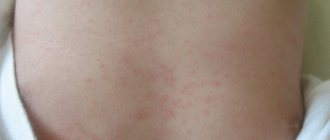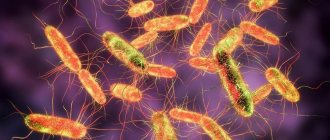Classification of autonomic disorders
Depending on the intensity, origin, and nature of autonomic disorders, several subgroups of VSD are distinguished.
Depending on the cause, psychogenic, hereditary, infectious and dyshormonal forms of vegetative-vascular dystonia are distinguished; in some cases, children have a mixed type of VSD, which is characterized by a combination of several causes of symptoms.
According to the nature of the disorders, the syndrome is:
- sympathicotonic, when the disorder is expressed in restless, overly emotional and even aggressive behavior;
- vagotonic, which manifests itself in the form of chills, increased or decreased body temperature, dizziness, sensation of a foreign body in the throat;
- combined, when there is no clear predominance of certain symptoms.
There are also systemic, local and generalized forms of pathology according to the degree of prevalence of disorders. According to the severity of VSD disorders, there are mild, moderate and severe forms.
Symptoms
Manifestations of vegetative-vascular dystonia in children and adolescents are diverse and diverse; in fact, any symptoms of deterioration in general physical and psycho-emotional well-being can fit under this concept. In total, about 30 different syndromes have been described based on more than 150 complaints.
Basically, symptoms of VSD in children and adolescents include disorders of the central nervous system, cardiovascular system, respiratory system, and gastrointestinal tract. The most common signs were:
- increased fatigue;
- sleep disorders;
- dizziness;
- cardiopalmus;
- arrhythmia;
- changes in blood pressure;
- headache;
- diarrhea;
- feeling of lack of air;
- increased body temperature without signs of infection;
- change in pupil size;
- muscle and joint pain;
- chills;
- hand tremors;
- increased sweating;
- cold extremities;
- pain in the heart area.
In adolescence, in boys and girls, VSD often manifests itself as increased anxiety, unreasonable fears, and sudden changes in mood. In some cases, parents note excessive emotionality, violent expression of feelings, and sometimes unmotivated aggression and anger.
Varieties
Based on the different reactions of both the autonomic and cardiovascular systems, as well as the presence of characteristic accompanying symptoms, various variants of VSD are distinguished:
- Hypertensive form, characterized by increased blood pressure, tachycardia, and headache attacks.
- Hypotonic state, accompanied by regular fatigue, sudden dizziness, and fatigue too quickly. In such cases, constant manifestations of headache develop. The overall picture is complemented by a drop in blood pressure, fainting and periodic nausea.
- The cardiac group is expressed by problems in the functioning of the heart rhythm, pain in the heart area, while there are no symptoms of ischemia.
- The mixed form is the most common. A child can feel discomfort in different systems and organs. Additionally, against the background of such a picture, problems arise with the functioning of the gastrointestinal tract.
The discomfort associated with such a diagnosis is very varied. These problems cannot always be seen immediately, so the patient should visit a doctor and undergo an instrumental examination. When visiting the clinic, the pediatrician collects anamnesis and clarifies the types of unpleasant discomfort.
Manifestations of pathology are classified into the following three groups:
- Persistent, occurring regularly with a characteristic or slight deterioration in well-being for several hours.
- Hidden. They arise after exposure to certain provocateurs: fatigue, sudden emotional excitement, poor night's rest.
- Crisis. They appear suddenly, without the patient being exposed to any external stimuli. This feeling goes away quickly.
When diagnosing VSD in a child, the doctor chooses the tactics of non-drug symptomatic complex therapy. With further restructuring of the body, many children outgrow the pathology as they overcome puberty.
Reasons for the development of the syndrome
As well as signs, there are many reasons for the occurrence of vegetative-vascular dystonia in childhood.
In some cases, the pathology is hereditary in nature and is caused by congenital dysfunctions of the autonomic system. As a rule, such deviations are passed on to the child through the mother. In each specific case, for effective treatment of VSD in adolescents and children, it is necessary to reliably identify the primary disease or complex of pathologies that caused autonomic disorders. The most common reasons were:
- diseases of the central nervous system;
- a sharp change in hormonal levels;
- allergic pathologies;
- acute and chronic infections;
- features of maturation and development of the child’s autonomic system;
- pathologies of the endocrine system;
- head and neck injuries;
- vascular diseases.
In adolescence, smoking, including passive smoking, can cause deterioration in the functioning of the autonomic system. Often the mechanism of VSD is triggered by stress, mental and physical strain, violent quarrels with loud expressions of feelings.
In preschoolers and primary school students, disorders can be triggered by excessive workload, unfavorable environmental background, diseases suffered during fetal development or in early childhood.
Treatment: how to help a child?
In childhood, it is extremely important to use an integrated approach for treatment. At the core, it is necessary to pay due attention to psychological support and assistance, lifestyle correction, nutrition, work and rest regime. And only after resorting to drug therapy for vegetative-vascular dystonia in adolescents and children. It is also extremely important to follow these recommendations:
- Provide adequate rest to the child, night and daytime sleep.
- Adjust physical activity, sports should be moderate and dosed.
- Nutrition is complete and balanced.
- Don't yell at your child or make him cry or hysterical.
- In conflict situations, do not speak in a raised voice.
The following methods are used in the treatment of vegetative-vascular dystonia:
- Physiotherapy, electrophoresis, electrosleep.
- Therapeutic exercise therapy, swimming.
- Massage, general, neck and head areas, back.
- A conversation with a psychologist and a questionnaire to identify problematic situations in kindergarten, school, and in the family.
- Herbal medicine, replacing strong black tea with herbal and homeopathic preparations.
Drug therapy is used exclusively for severe dystonia in children, if the above methods were not effective. Identification of symptoms and treatment of vegetative-vascular dystonia should only be carried out by a specialist in the clinic, a pediatrician, neurologist or cardiologist. Therapy is prescribed after a diagnostic examination according to the protocol and receipt of a final diagnosis.
Diagnosis of VSD
The initial stage of the examination is the collection of a detailed medical history. The doctor needs to know almost everything about the little patient:
- age;
- features of intrauterine development, birth and the first years of life;
- past illnesses and surgeries;
- frequency of diseases per year;
- completed treatment;
- environmental situation in the place of residence.
The specialist needs to painstakingly collect all available information, including observations of parents, complaints of the child himself, and lifestyle features.
After collecting an anamnesis, a general examination is carried out, during which the doctor assesses the condition of the skin, mucous membranes of the nose and oral cavity, lymph nodes and other visible structures.
The next stage of diagnosis is laboratory and instrumental examination methods. Depending on the direction of symptoms and complaints, the following are performed:
- a set of laboratory tests of blood and urine;
- Ultrasound;
- MRI or CT;
- breath tests;
- allergy tests;
- EchoCG and ECG;
- electroencephalography;
- fluoroscopy.
Additionally, the attending physician can refer the child to a consultation with an ophthalmologist, surgeon, urologist, gynecologist, or otolaryngologist.
Treatment of vegetative-vascular dystonia in children
Treatment of VSD in children involves, first of all, relieving unpleasant symptoms and searching for the pathology that provoked the syndrome. A set of treatment methods is selected depending on the nature of the disorders and may include:
- various physiotherapeutic procedures;
- massage;
- various breathing exercises;
- physical therapy course;
- drug support.
It is highly desirable to correct the lifestyle of children with signs of vegetative-vascular dystonia. To reduce negative manifestations and prevent further worsening of the syndrome, children and adolescents need to:
- sleep at least 8 hours a day;
- maintain a daily routine;
- eat properly and balanced;
- undergo regular preventive examinations;
- do physical education.
Parents need to provide a comfortable and friendly environment at home, provide psychological support to their children, and promptly and adequately treat infectious diseases and injuries. Treatment of the disease can only be prescribed by a doctor; self-medication is strictly prohibited.
Prevention of VSD
General strengthening measures, timely vaccination, and prevention of potential risk factors will help prevent the occurrence of vegetative-vascular dystonia in childhood and adolescence. Experts recommend not overloading young children with excessive activities, and providing teenagers with comprehensive assistance in their studies and creativity.
It is important to closely monitor the child’s health, not to try untested or questionable methods in the child’s therapy, and not to give narrow-spectrum drugs as self-medication.
If you suspect VSD, contact a professional: our specialists will find the cause of autonomic disorders, select an individual treatment regimen and corrective techniques, taking into account all the characteristics of your child.
Principles of prevention of vegetative-vascular dystonia
- Measured rhythm of life. This means that the child needs a daily routine, but it is important not to burden his life with a large number of events. There is no need to follow a rigid schedule, but key events should be predictable.
- Sufficient emotional communication with loved ones . In the first years of life, the intellectual and physical development of the child depends on emotional communication with the mother. The quality of contact and parental involvement in communication is more important than the amount of time spent together. This lays the foundation for psychological and neurological health.
- Physical activity that is feasible for a child brings him pleasure. Stimulation of muscle fibers and receptors of the musculoskeletal system helps regulate the activity of the sympathetic and parasympathetic departments. Professional sports is not a measure to prevent VSD.
- Any activity that brings psychological relief . Active recreation, communication with friends, pursuit of interests.
- A sufficient amount of protein and fat in the diet of a child of any age helps maintain the health of the peripheral nervous system and improves its adaptive properties.
- From 12 years of age, Eltacin® . This is a drug made from the amino acids glycine, cystine and glutamic acid, it can be used for a long time and does not accumulate in the body. The pharmacological action of Eltacin® is based on improving cellular respiration and increasing the amount of endogenous glutathione, which is a strong antioxidant.










